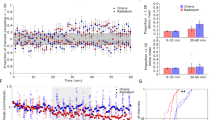Abstract
A WIDESPREAD interest in a long-lasting form of synaptic enhancement in hippocampal circuits1,2 has arisen largely because it might reflect the activation of physiological mechanisms that underlie rapid associative learning. As its induction normally requires the 'Hebbian'3 association of activity on a number of input fibres4, we refer to the process as long-term enhancement (LTE) rather than long-term potentiation (LTP), to emphasize its distinction from the ubiquitous, non-associative 'potentiation' phenomena that occur at most synapses, including those exhibiting LTE5. Among other evidence6–8 that LTE might actually have a role in associative memory is the demonstration that repeated high-frequency stimulation, which saturated the induceable LTE, caused a severe deficit in spatial learning, although it had no effect on well established spatial memory9. These results were consistent with a widespread view that information need only temporarily be stored in the hippocampal formation in order for long-term memories to be established in neocortical circuits10,11. In this context, it is important to understand whether the possible underly-ing synaptic changes are of a permanent character, or are relatively transient. A second question is whether the actual cause of the observed learning deficit is the distruption of the synaptic weight distribution, and/or the limitation of further synaptic change, which presumably results from experimental saturation of the LTE mechanism. Alternatively, the deficit could be a consequence of some unobserved secondary effect of the high-frequency electrical stimulation. Here we demonstrate that learning capacity recovers in about the same time that it takes LTE to decay, which strongly favours the first possibility and supports the idea that LTE-like processes actually underlie associative memory.
This is a preview of subscription content, access via your institution
Access options
Subscribe to this journal
Receive 51 print issues and online access
$199.00 per year
only $3.90 per issue
Buy this article
- Purchase on Springer Link
- Instant access to full article PDF
Prices may be subject to local taxes which are calculated during checkout
Similar content being viewed by others
References
Bliss, T. V. P. & Gardner-Medwin, A. J. Physiol 232, 357–374 (1973).
Bliss, T. V. P. & Lomo, T. J. Physiol. 232, 331–356 (1973).
Hebb, D. O. The Organization of Behavior (Wiley, New York, 1949).
McNaugbton, B. L., Douglas, R. M. & Goddard, G. V. Brain Res. 157, 277–293 (1978).
McNaughton, B. I. J. Physiol. 324, 249–262 (1982).
Barnes, C. A. J. comp. physiol. Psychol. 93, 74–104 (1979).
Barnes, C. A. & McNaughton, B. L. Behav. Neursci. 99, 1040–1048 (1985).
Morris, R. G. M., Anderson, E., Lynch, G. S. & Baudry, M. Nature 319, 774–776 (1986).
McNaughton, B. L., Barnes, C. A., Rao, G., Baldwin, J. & Rasmussen, M. J. Neurosci. 6, 563–571 (1986).
Marr, D. Phil. Trans. R. Soc. 262, 23–80 (1971).
Squire, L. R., Cohen, N. J. & Nadel, L. in Memory Consolidation (eds Weingartner, N. M. & Parker, E.) 185–210 (Erlbaum, Hillsdale, New Jersey, 1984).
Barnes, C. A. & McNaughton, B. L. in Psychobiology of Ageing: Problems and Perspectives (ed. Stein, D. O.) 253–273 (Elsevier, Amsterdam, 1980).
Staubli, U. & Lynch, G. Brain Res. 435, 227–234 (1987).
Author information
Authors and Affiliations
Rights and permissions
About this article
Cite this article
Castro, C., Silbert, L., McNaughton, B. et al. Recovery of spatial learning deficits after decay of electrically induced synaptic enhancement in the hippocampus. Nature 342, 545–548 (1989). https://doi.org/10.1038/342545a0
Received:
Accepted:
Issue Date:
DOI: https://doi.org/10.1038/342545a0
This article is cited by
-
Hippocampus-Dependent Learning Deficit Does Not Correlate with Suppression of Long-Term Post-Tetanic Potentiation by Systemic Blockade of NMDA Receptors
Neuroscience and Behavioral Physiology (2023)
-
Increasing CREB Function in the CA1 Region of Dorsal Hippocampus Rescues the Spatial Memory Deficits in a Mouse Model of Alzheimer's Disease
Neuropsychopharmacology (2011)
-
Reactivation of experience-dependent cell assembly patterns in the hippocampus
Nature Neuroscience (2008)
-
Learning-Induced Synchronization and Plasticity of a Developing Neural Network
Journal of Computational Neuroscience (2005)
-
Thyrotropin-releasing hormone inhibits long-term potentiation in synaptic systems of rat hippocampus
Bulletin of Experimental Biology and Medicine (1999)
Comments
By submitting a comment you agree to abide by our Terms and Community Guidelines. If you find something abusive or that does not comply with our terms or guidelines please flag it as inappropriate.



